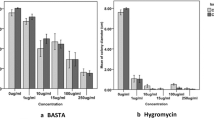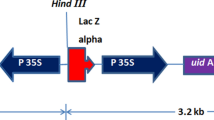Abstract
Cassava (Manihot esculenta Crantz) is a major staple food crop of the humid tropics. As a heterozygous, vegetatively propagated crop, robust transformation protocols must be developed for elite cultivars that allow predictable production of large numbers of independent transgenic plant lines. A high throughput Agrobacterium-mediated transformation system was developed for the elite East African farmer-preferred cassava cultivar TME 204 using the GFP visual marker gene. Inclusion of the antibiotic moxalactam in culture medium used to produce embryogenic target tissues prior to inoculation with Agrobacterium increased recovery of independent GFP-expressing transgenic callus lines by up to 113-fold compared to the control. Enhanced transformation was also observed when TME 204 tissues were pretreated with other cephalosporins, namely cefoperazone, cefoxitin, cefmetazole and cefotaxime. Similar but less dramatic increases in transformation efficiencies were seen for the West African cultivars Oko-iyawo and 60444 when pre-treated with moxalactam. Dilution of Agrobacterium suspensions used for co-culture was found to increase transformation efficiencies, resulting in regeneration at an average of 33 GFP-expressing TME 204 plants per cc settled cell volume at OD600 0.05, compared to 15 plants at the more commonly used OD600 0.5. The optimized transformation systems were successfully utilized for the integration of genetic constructs for disease resistance and nutritional enhancement into more than 750 plants of TME 204.






Similar content being viewed by others
References
Ademiluyi FT, Mepba HD (2013) Yield and properties of ethanol biofuel produced from different whole cassava flours. ISRN Biotechnol. doi:10.5402/2013/916481
Amoah BK, Wu H, Sparks C, Jones HD (2001) Factors influencing Agrobacterium-mediated transient expression of uidA in wheat inflorescence tissue. J Exp Bot 52:1135–1142
Archilletti T, Lauri P, Damiano C (1995) Agrobacterium-mediated transformation of almond leaf pieces. Plant Cell Rep 14:267–272. doi:10.1007/BF00232026
Balagopalan C (2002) Cassava utilization in food, feed and industry. In: Hillocks RJ, Thresh JM, Bellotti AC (eds) Cassava: biology, production and utilization. CABI, Wallingford, pp 301–318
Bull SE, Owiti JA, Niklaus M, Beeching JR, Gruissem W, Vanderschuren H (2009) Agrobacterium-mediated transformation of friable embryogenic calli and regeneration of transgenic cassava. Nat Protoc 4:1845–1854. doi:10.1038/nprot.2009.208
Ceballos H, Iglesias CA, Perez JC, Dixon AG (2004) Cassava breeding: opportunities and challenges. Plant Mol Biol 56:503–516. doi:10.1007/s11103-004-5010-5
Corredoira E, San-Jose MC, Ballester A, Vieitez AM (2005) Genetic transformation of Castanea sativa Mill. by Agrobacterium tumefaciens. Acta Hortic 693:387–394
Doyle JJ, Doyle JL (1990) Isolation of plant DNA from fresh tissue. Focus 12:13–15
Driver JA, Kuniyuki AH (1984) In vitro propagation of Paradox walnut rootstock. HortScience 19:507–509
FAO (2008) Cassava. In. http://www.fao.org/ag/AGP/agpc/gcds/index_en.html
Fregene M, Sayre RT, Fauquet CM, Anderson P, Taylor NJ, Cahoon E, Siritunga D, Manary M (2010) Opportunities for biofortification of cassava for Sub-Saharan Africa: the BioCassava Plus Program. In: Eaglesham A, Bennett AB, Hardy RWF (eds) Promoting Health by Linking Agriculture, Food, and Nutrition. Proceedings of the twenty-second annual conference of the National Agricultural Biotechnology Council, University of California, Davis. vol NABC Report 22. National Agricultural Biotechnology Council, NABC Report 22, 16–18 June 2010, p 81–90
Gresshoff PM, Doy CH (1974) Derivation of a haploid cell line from Vitis vinifera and the importance of the stage of meiotic development of the anthers for haploid culture of this and other genera. Z Pflanzenphysiol 73:132–141
Jorgensen K, Bak S, Busk PK, Sorensen C, Olsen CE, Puonti-Kaerlas J, Moller BL (2005) Cassava plants with a depleted cyanogenic glucoside content in leaves and tubers. Distribution of cyanogenic glucosides, their site of synthesis and transport, and blockage of the biosynthesis by RNA interference technology. Plant Physiol 139:363–374. doi:10.1104/pp.105.065904
Legg JP, Jeremiah SC, Obiero HM, Maruthi MN, Ndyetabula I, Okao-Okuja G, Bouwmeester H, Bigirimana S, Tata-Hangy W, Gashaka G, Mkamilo G, Alicai T, Kumar PL (2011) Comparing the regional epidemiology of the cassava mosaic and cassava brown streak virus pandemics in Africa. Virus Res 159:161–170
Li HQ, Sautter C, Potrykus I, Puonti-Kaerlas J (1996) Genetic transformation of cassava (Manihot esculenta Crantz). Nat Biotechnol 14:736–740. doi:10.1038/nbt0696-736
Liu J, Zheng Q, Ma Q, Gadidasu KK, Zhang P (2011) Cassava genetic transformation and its application in breeding. J Integr Plant Biol 53:552–569. doi:10.1111/j.1744-7909.2011.01048.x
Marcon MJA, Vieira GCN, de Simas KN, Santos K, Vieira MA, Amboni RDMC, Amante ER (2007) Effect of the improved fermentation on physicochemical properties and sensorial acceptability of sour cassava starch. Braz Arch Biol Technol 50:1073–1081
Mayolo G, Maximova SN, Pishak S, Guiltinan MJ (2003) Agrobacterium mediated transformation and its positive effects on Theobroma cacao somatic embryogenesis. Plant Sci 164:607–615
Mohd Aripin A, Mohd Kassim AS, Daud Z, Mohd Hatta MZ (2013) Cassava peels for alternative fibre in pulp and paper industry: chemical properties and morphology characterization. Int J Integr Eng 5:30–33
Msikita W, Ihemere U, Siritunga D, Sayre RT (2006) Cassava (Manihot esculenta Crantz) transformation. In: Wang K (ed) Agrobacterium protocols: methods in molecular biology, vol 44. Humana Press, New York City
Murashige T, Skoog F (1962) A revised medium for rapid growth and bio assays with tobacco tissue cultures. Physiol Plant 15:473–497
Nuwamanya E, Chiwona-Karltun L, Kawuki RS, Baguma Y (2012) Bio-ethanol production from non-food parts of cassava (Manihot esculenta Crantz). Ambio 41:262–270. doi:10.1007/s13280-011-0183-z
Nwokoro SO, Orheruata AM, Ordiah PI (2002) Replacement of maize with cassava sievates in cockerel starter diets: effect on performance and carcass characteristics. Trop Anim Health Prod 34:163–167
Nyaboga E, Njiru J, Nguu E, Gruissem W, Vanderschuren H, Tripathi L (2013) Unlocking the potential of tropical root crop biotechnology in east Africa by establishing a genetic transformation platform for local farmer-preferred cassava cultivars. Front Plant Sci 4:526. doi:10.3389/fpls.2013.00526
Odipio J, Ogwok E, Taylor NJ, Halsey M, Bua A, Fauquet CM, Alicai T (2014) RNAi-derived field resistance to cassava brown streak disease persists across the vegetative cropping cycle. GM Crops Food Biotechnol Agric Food Chain 5:16–19
Ogawa Y, Mii M (2007) Meropenem and moxalactam: novel β-lactam antibiotics for efficient Agrobacterium-mediated transformation. Plant Sci 172:564–572
Ogwok E, Odipio J, Halsey M, Gaitan-Solis E, Bua A, Taylor NJ, Fauquet CM, Alicai T (2012) Transgenic RNA interference (RNAi)-derived field resistance to cassava brown streak disease. Mol Plant Pathol 13:1019–1031
Sambrook JF, Russell DW (2001) Molecular cloning: a laboratory manual, 3rd edn. Cold Spring Harbor Laboratory Press, New York
Sayre R, Beeching JR, Cahoon EB, Egesi C, Fauquet CM, Fellman J, Fregene M, Gruissem W, Mallowa S, Manary M, Maziya-Dixon B, Mbanaso A, Schachtman DP, Siritunga D, Taylor NJ, Vanderschuren H, Zhang P (2011) The BioCassava plus program: biofortification of cassava for Sub-Saharan Africa. Annu Rev Plant Biol 62:251–272. doi:10.1146/annurev-arplant-042110-103751
Schreuder MM, Raemakers CJJM, Jacobsen E, Visser RGF (2001) Efficient production of transgenic plants by Agrobacterium-mediated transformation of cassava (Manihot esculenta Crantz). Euphytica 120:35–42
Shackelford NJ, Chlan CA (1996) Identification of antibiotics that are effective in eliminating Agrobacterium tumefaciens. Plant Mol Biol Rep 14:50–57
Srinivas T (2007) Industrial demand for cassava starch in India. Starch/Stärke 59:477–481. doi:10.1002/star.200700657
Taylor NJ, Chavarriaga P, Raemakers K, Siritunga D, Zhang P (2004) Development and application of transgenic technologies in cassava. Plant Mol Biol 56:671–688. doi:10.1007/s11103-004-4872-x
Taylor N, Gaitan-Solis E, Moll T, Trauterman B, Jones T, Pranjal A, Trembley C, Abernathy V, Corbin D, Fauquet CM (2012) A High-throughput platform for the production and analysis of transgenic cassava (Manihot esculenta) plants. Trop Plant Biol 5:127–139
Yadav JS, Ogwok E, Wagaba H, Patil BL, Bagewadi B, Alicai T, Gaitan-Solis E, Taylor NJ, Fauquet CM (2011) RNAi-mediated resistance to cassava brown streak Uganda virus in transgenic cassava. Mol Plant Pathol 12:677–687. doi:10.1111/j.1364-3703.2010.00700.x
Yadav SK, Katikala S, Yellisetty V, Kannepalle A, Narayana JL, Maddi V, Mandapaka M, Shanker AK, Bandi V, Bharadwaja KP (2012) Optimization of Agrobacterium mediated genetic transformation of cotyledonary node explants of Vigna radiata. Springerplus 1:59. doi:10.1186/2193-1801-1-59
Zainuddin IM, Schlegel K, Gruissem W, Vanderschuren H (2012) Robust transformation procedure for the production of transgenic farmer-preferred cassava landraces. Plant Methods 8:24. doi:10.1186/1746-4811-8-24
Zhang P, Jaynes JM, Potrykus I, Gruissem W, Puonti-Kaerlas J (2003) Transfer and expression of an artificial storage protein (ASP1) gene in cassava (Manihot esculenta Crantz). Transgenic Res 12:243–250
Zhang P, Vanderschuren H, Futterer J, Gruissem W (2005) Resistance to cassava mosaic disease in transgenic cassava expressing antisense RNAs targeting virus replication genes. Plant Biotechnol J 3:385–397. doi:10.1111/j.1467-7652.2005.00132.x
Acknowledgments
This work was supported by the Bill and Melinda Gates Foundation, the United States Agency for International Development from the American people, and the Monsanto Fund. PureMLB® technology was kindly donated by Japan Tobacco Inc. We thank Dr. Edgar Cahoon, Director of the Center for Plant Science Innovation, University of Nebraska-Lincoln, for providing expression cassettes of crtB and DXS. We also thank Tira Jones, Jacquelyn Leise, Amita Rai, Jackson Gehan, Theodore Moll and Danielle Posey at the Donald Danforth Plant Science Center for technical assistance.
Conflict of interest
The authors declare that they do not have any conflict of interest.
Author information
Authors and Affiliations
Corresponding author
Rights and permissions
About this article
Cite this article
Chauhan, R.D., Beyene, G., Kalyaeva, M. et al. Improvements in Agrobacterium-mediated transformation of cassava (Manihot esculenta Crantz) for large-scale production of transgenic plants. Plant Cell Tiss Organ Cult 121, 591–603 (2015). https://doi.org/10.1007/s11240-015-0729-z
Received:
Accepted:
Published:
Issue Date:
DOI: https://doi.org/10.1007/s11240-015-0729-z




